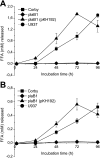Phospholipase PlaB of Legionella pneumophila represents a novel lipase family: protein residues essential for lipolytic activity, substrate specificity, and hemolysis
- PMID: 19640837
- PMCID: PMC2785646
- DOI: 10.1074/jbc.M109.026021
Phospholipase PlaB of Legionella pneumophila represents a novel lipase family: protein residues essential for lipolytic activity, substrate specificity, and hemolysis
Abstract
Legionella pneumophila possesses several phospholipases capable of host cell manipulation and lung damage. Recently, we discovered that the major cell-associated hemolytic phospholipase A (PlaB) shares no homology to described phospholipases and is dispensable for intracellular replication in vitro. Nevertheless, here we show that PlaB is the major lipolytic activity in L. pneumophila cell infections and that PlaB utilizes a typical catalytic triad of Ser-Asp-His for effective hydrolysis of phospholipid substrates. Crucial residues were found to be located within the N-terminal half of the protein, and amino acids embedding these active sites were unique for PlaB and homologs. We further showed that catalytic activity toward phosphatidylcholine but not phosphatidylglycerol is directly linked to hemolytic potential of PlaB. Although the function of the prolonged PlaB C terminus remains to be elucidated, it is essential for lipolysis, since the removal of 15 amino acids already abolishes enzyme activity. Additionally, we determined that PlaB preferentially hydrolyzes long-chain fatty acid substrates containing 12 or more carbon atoms. Since phospholipases play an important role as bacterial virulence factors, we examined cell-associated enzymatic activities among L. pneumophila clinical isolates and non-pneumophila species. All tested clinical isolates showed comparable activities, whereas of the non-pneumophila species, only Legionella gormanii and Legionella spiritensis possessed lipolytic activities similar to those of L. pneumophila and comprised plaB-like genes. Interestingly, phosphatidylcholine-specific phospholipase A activity and hemolytic potential were more pronounced in L. pneumophila. Therefore, hydrolysis of the eukaryotic membrane constituent phosphatidylcholine triggered by PlaB could be an important virulence tool for Legionella pathogenicity.
Figures





Similar articles
-
Oligomerization inhibits Legionella pneumophila PlaB phospholipase A activity.J Biol Chem. 2014 Jul 4;289(27):18657-66. doi: 10.1074/jbc.M114.573196. Epub 2014 May 8. J Biol Chem. 2014. PMID: 24811180 Free PMC article.
-
Cloning and characterization of the gene encoding the major cell-associated phospholipase A of Legionella pneumophila, plaB, exhibiting hemolytic activity.Infect Immun. 2004 May;72(5):2648-58. doi: 10.1128/IAI.72.5.2648-2658.2004. Infect Immun. 2004. PMID: 15102773 Free PMC article.
-
Phospholipase PlaB is a new virulence factor of Legionella pneumophila.Int J Med Microbiol. 2010 Jun;300(5):313-23. doi: 10.1016/j.ijmm.2010.01.002. Epub 2010 Feb 12. Int J Med Microbiol. 2010. PMID: 20153694
-
The manifold phospholipases A of Legionella pneumophila - identification, export, regulation, and their link to bacterial virulence.Int J Med Microbiol. 2008 Apr;298(3-4):169-81. doi: 10.1016/j.ijmm.2007.11.004. Epub 2008 Jan 4. Int J Med Microbiol. 2008. PMID: 18178130 Review.
-
Secreted phospholipases of the lung pathogen Legionella pneumophila.Int J Med Microbiol. 2018 Jan;308(1):168-175. doi: 10.1016/j.ijmm.2017.10.002. Epub 2017 Oct 28. Int J Med Microbiol. 2018. PMID: 29108710 Review.
Cited by
-
Oligomerization inhibits Legionella pneumophila PlaB phospholipase A activity.J Biol Chem. 2014 Jul 4;289(27):18657-66. doi: 10.1074/jbc.M114.573196. Epub 2014 May 8. J Biol Chem. 2014. PMID: 24811180 Free PMC article.
-
Unusual Lipid Components of Legionella gormanii Membranes.Metabolites. 2022 May 6;12(5):418. doi: 10.3390/metabo12050418. Metabolites. 2022. PMID: 35629922 Free PMC article.
-
Insight into the Mechanism of Interactions between the LL-37 Peptide and Model Membranes of Legionella gormanii Bacteria.Int J Mol Sci. 2023 Jul 27;24(15):12039. doi: 10.3390/ijms241512039. Int J Mol Sci. 2023. PMID: 37569419 Free PMC article.
-
Update on Legionnaires' disease: pathogenesis, epidemiology, detection and control.Mol Microbiol. 2010 Apr;76(1):1-11. doi: 10.1111/j.1365-2958.2010.07086.x. Epub 2010 Feb 10. Mol Microbiol. 2010. PMID: 20149105 Free PMC article.
-
NAD(H)-mediated tetramerization controls the activity of Legionella pneumophila phospholipase PlaB.Proc Natl Acad Sci U S A. 2021 Jun 8;118(23):e2017046118. doi: 10.1073/pnas.2017046118. Proc Natl Acad Sci U S A. 2021. PMID: 34074754 Free PMC article.
References
-
- Bender J., Flieger A. (2009) Microbiology of Hydrocarbons, Oils, Lipids, and Derived Compounds, Springer-Verlag GmBH, Heidelberg, Germany, in press
-
- Istivan T. S., Coloe P. J. (2006) Microbiology 152, 1263–1274 - PubMed
-
- Schmiel D. H., Miller V. L. (1999) Microbes Infect. 1, 1103–1112 - PubMed
-
- Jepson M., Titball R. (2000) Microbes Infect. 2, 1277–1284 - PubMed
-
- Phillips R. M., Six D. A., Dennis E. A., Ghosh P. (2003) J. Biol. Chem. 278, 41326–41332 - PubMed
Publication types
MeSH terms
Substances
LinkOut - more resources
Full Text Sources

